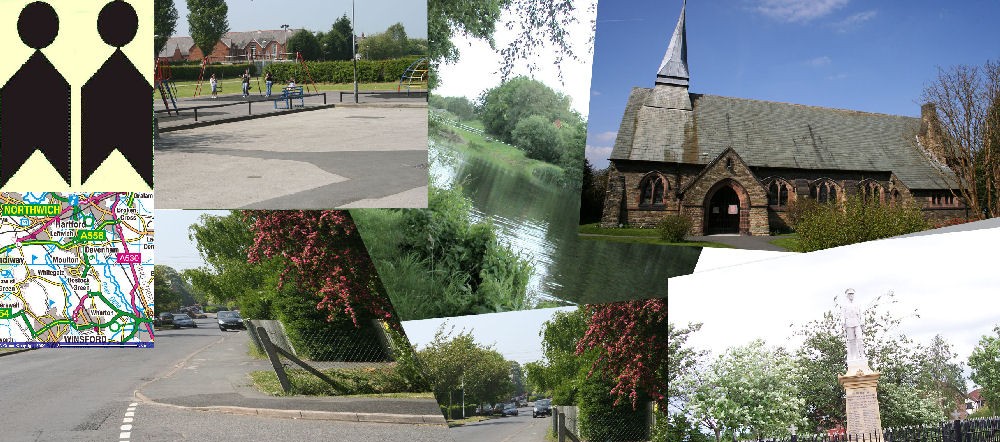Moulton lies in mid Cheshire, 3 miles south of Northwich and 3 miles north of Winsford.It is bounded to the north by Davenham, to the west by the river Weaver and to the south east by Bostock. 
The village can trace its history back to the Norman Conquest. Moletune is listed in the Domesday Book of 1086 as being among the estates of Baron Richard de Vernon of Shipbrook. George Ormerod described the village in 1882 thus:
‘Moulton occupies a high ridge of ground, running parallel with the general course of the Weever, and commanding a most extensive view over the vales of that river, and of the Mersey, in the several directions of Delamere Forest and Lancashire.’ During the 19th century the character of the village changed from purely agricultural to a more mixed economy. Many workers in the salt mining industry, which lined the banks of the River Weaver, made their homes in Moulton. The factory owners built the terraced housing in Church Street and Regent Street for their employees.
A walk through the centre of the village itself reveals much of interest. The Methodist Chapel dates from 1875; the Co-Operative Store was built in 1894; and nearby Moulton Cottage with its dated clock of 1871 was formerly Mr. Wilson’s Shoe Shop where clogs were made.
The village developed with the growth of the salt industry in Winsford. In 1876 the Rev Thomas France-Hayhurst of Bostock Hall sponsored the building of a new church dedicated to St. Stephen the Martyr. The church was designed by John Douglas and the foundation stone was laid in 1876. In 1877 St Stephen’s was established as a separate parish and the church was consecrated on 16 January 1877 by Dr William Jacobson, Bishop of Chester.
After the Second World War this industry quickly declined as new methods of abstracting salt by solution mining replaced the old fashioned pumping of wild brine and its attendant subsidence.
The village quickly became a residential area with most folk working in nearby Northwich or Winsford.
 |
New housing development in the mid 1960’s considerably increased the population by over 60%. Many of the new residents had young families who wanted improved community facilities.
In 1972 the Parish Council held a public meeting in the Primary School to bring all the interested parties together. This meeting led to the founding of Moulton and District Community Association (MADCA) in June 1973.
One of the main objectives of MADCA was to provide a proper Village Hall with facilities for a range of community  activities. Negotiations were soon underway with the Church of England to take over the old Church Hall, which had suffered form neglect over the years and was in an extremely poor state of repair. After many legal minefields had been traversed MADCA took over the Hall in May 1976.
activities. Negotiations were soon underway with the Church of England to take over the old Church Hall, which had suffered form neglect over the years and was in an extremely poor state of repair. After many legal minefields had been traversed MADCA took over the Hall in May 1976.

 The real work then began with bands of volunteers raising money and carrying out repairs and improvements. Grants were obtained from the Government and local authorities to supplement the locally raised funds.
The real work then began with bands of volunteers raising money and carrying out repairs and improvements. Grants were obtained from the Government and local authorities to supplement the locally raised funds.
For several years weekends became a time to practise building skills. In 1982 and two major extensions later, the hall was formally reopened as Moulton Village Hall.
During the six years it took to completely refurbish our Hall many new societies were formed – Scouts, Guides and Brownies, Mother and Toddler Group, Moulton Drama Group, dancing classes, an Art Class, Prize Bingo and Coffee & Chat all supplemented existing organisations.
Thirty eight years on Moulton Village Hall continues to be a venue for local organisations. Many draw their membership from the surrounding area as well as from the village itself.
Sadly MADCA had to relinquish management of the hall due to the advancing age of the band of volunteers. It has now reverted to the control of St Stephen’s Church.









